Travel: Vignettes from China
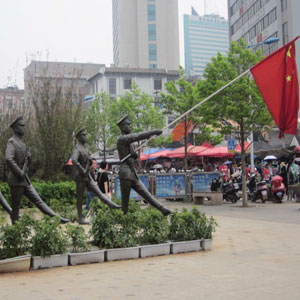
Travelers to India and China alike will detect a palpable buzz in the air... of good times, great jobs, free-flowing wealth, general optimism and bonhomie. Shopping malls, luxury brands, and flashy new cars signal changing times in India, but on a much larger scale in China.
A huge billboard outside the international airport in Kunming, Yunnan Province, greets travelers as they enter and exit the airport. It sports a quote from Warren Buffett. His name is spelled out in English, but the actual quote is in Mandarin. Surely, this can’t be a quote by Buffett extolling communism, I think to myself. Nobody quotes Buffett on communism or the ills of capitalism. Even I, with my truncated knowledge of stocks and shares could tell you that Mr. Buffett is exhorting you to make money, albeit in Mandarin. That’s “socialism with Chinese characteristics”— a phrase you hear quite often in China.
I was in China for two weeks, to participate in two training workshops offered by my employer to their Chinese counterparts. Having traveled mostly within the Romance language parts of the world, I knew that the only thing that I could do to prepare for my trip was to arm myself with inane factoids about China such as this one: did you know that three out of four tall building cranes in the world can be found in China? It felt like I must have encountered all but one of those cranes during my travels in China. Try this other factoid on for size: the Chinese communist party anointed a small town in the southwestern Yunnan Province as Shangri-La? Yes, Joseph Hilton’s fictional Shangri-La is now an actual Chinese town. Or this: the largest peaceful migration of humans in modern times occurs when over 300 million Chinese workers hop on trains to visit their hometowns during the Chinese New Year holidays. Imagine if the entire population of the United States were to pack their bags and head off to various destinations. And this: a city in China is considered mid-sized if its population is only around 5 million.
I look back on my two weeks in China and search vainly for one word to capture my impressions. The words I find are all prefixed with “awe”—awe-inspiring, awestruck, and with a little stretch, awe-ful (and awe-mazing). My mind’s eye is peppered with images of broad highways snaking through anonymous exurbia peppered with gleaming new skyscrapers, and cranes stretching far into the horizon.
For two weeks, I visited Nanjing (the erstwhile Nanking), Shanghai and Kunming. I learned and unlearned many things about its peoples, its culture, and its cuisine. As an Indian living in the United States and visiting China for the first time, I was weighed down by the self-imposed burden of having to make insightful commentary and observations on comparative socio-political economics. I know now that you can’t explain China in pithy one-liners just as you can’t explain India or even the United States.
Travelers to India and China alike will detect a palpable buzz in the air-of good times, great jobs, free-flowing wealth, general optimism and bonhomie. Shopping malls, luxury brands, and flashy new cars signal changing times in India, but on a much larger scale in China.
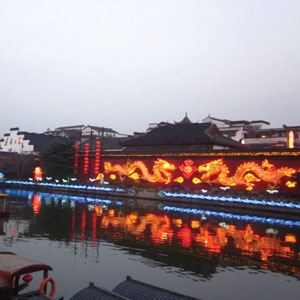
At the entrance to an outdoor mall in Nanjing, festively decorated with dragons and pagodas. A once legendary Confucius temple still occupies a tiny portion of this market place.
Nanjing, my first stop, in popular culture and history is known more for its gruesome past, where the Japanese in the late 1930s went on a six-week rampage, killed and raped countless. Today, Nanjing is a bustling metropolis of 5.5 million, less than two hours from Shanghai on high-speed bullet trains. Evidence of recent commercial and economic success abounds in Nanjing. The central Xinjiekou district sports fancy car dealerships and luxury stores like Hermes.
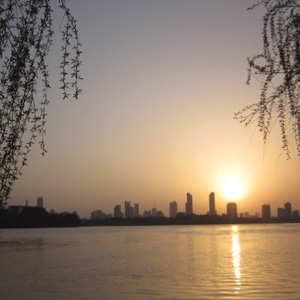
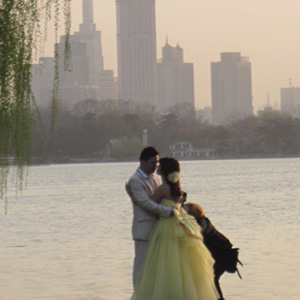
A couple posing for one of thousands of wedding portrait shots taken at the Xuanwu Lake Park in Nanjing.
The big central park in southeastern Nanjing attracts young couples chasing beautiful locales for wedding portraits. Thus, on a lazy Saturday afternoon I ran into a dozen young newlyweds posing in Mary Poppinslike dresses and Victorian tailcoats by the stone bridge here and by the grove of crepe myrtles there.
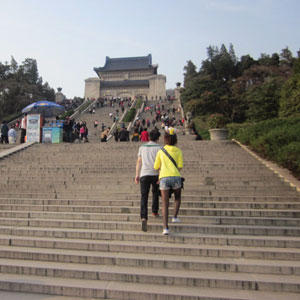
Climbing up the steps leading to Dr. Sun Yat-sen’s memorial in Nanjing. The views of the city from the top, clear skies permitting, are phenomenal.
Nanjing is home to Dr. Sun Yat-sen’s memorial. Sun Yat-sen, tour guides will be quick to point out, was a doctor who had trained in the United States and was the architect of modern China. Locals visiting the memorial were thrilled to see me and a fellow Indian colleague. We enjoyed minor celebrity status for all of two seconds while the digital cameras went click-click-click. The memorial site, accessible by stairs, provides magnificent vistas of the city. And, if the smog lifts, you may actually get to see it, too.
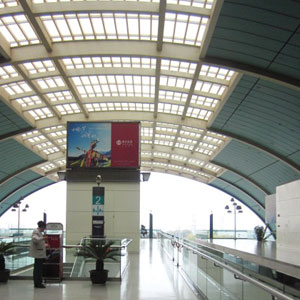
The Longyang Road high-speed Maglev (magnetic levitation) train station in Shanghai.
Both Shanghai and Nanjing are in Jiangsu Province on the eastern seaboard. Nanjing plays the younger sister to Shanghai’s ways. Shanghai, the pearl of the orient, is a metropolis of more than 20 million people. Public transport in both Nanjing and Shanghai are phenomenal. Shanghai’s metro system is extensive, easy to use, and safe. Nanjing, too, has a local metro. But my attempts to board a metro were thwarted by the deluge of local residents catching a train to head home for a short upcoming holiday. The scene at the metro stop reminded me of the thousands of devotees thronging Chennai Central during Sabarimala season. But taxis are just as easy to find. Since most taxi drivers are not conversant in English, I was advised to have my destinations written out in Mandarin.
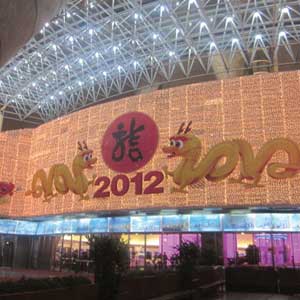
The French concession neighborhood of Shanghai, once home to the colonial French, boasts many restaurants and shopping areas popular with tourists and locals alike. It’s also home to Xintiandi, a super trendy, vehicle-free shopping and dining district.
The Bund is surely the best spot in town. A mixture of colonial era and modern architecture, it is a waterfront area that overlooks the Pudong area of Shanghai. Stretching along the Huangpu River for about a mile, the Bund is the most visited part of Shanghai. Packed on any given day, it’s especially picturesque at night, with buildings lit up on either side of the river. The trip would be incomplete without a ride on the train connecting it to Pudong; the ride lasts less than five minutes, but the rider is treated to psychedelic light and sound effects, much like the light effects in a seventies’ disco club. Cheesy, but fun.
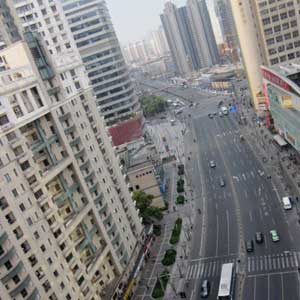
Shanghai is the ultimate shopper’s delight. Fancy a business suit? Pick the fabric and the style, and we will have it ready in a day. Fancy Louis Vuitton-emblazoned underwear? They have it. LV may not, but the tiny stores in the numerous malls will. Counterfeit Louis Vuitton umbrellas, Rosetta Stone knock-offs, and Tory Burch clutches—the U.S. customs and immigration, realizing the futility in banning the purchase or movement of these fake goods, actually allows you to carry one of each kind. But, fear not. If you were incensed at the insane number of fake good stores, there are malls that sell only genuine products, reflected in their giant signboards.
A recent David Sedaris piece on his experiences with food in China had me nervous. What will I get to eat, I wondered. Just chicken feet everywhere? Suffice it to say that if your culinary choices did not extend to chicken feet you will still find plenty of other delectable options for dining out. In Shanghai, I visited a “Muslim” restaurant. Yes, a restaurant self-titled “Muslim,” presumably because their specialty cuisines comes from the Western China, closer to the central Asian border which is home to Muslims. Aromatic lamb preparations and hearty soups are a staple here.
Yes, you will find chicken feet, but only if you ask for them. You could also enjoy some rattlesnake, but only if you asked for it. A small restaurant frequented by college students in Nanjing offered said soup with the entire chicken thrown in for good measure. Verdict? Delicious.
For vegetarians traveling to big Chinese cities, there are plenty of options. For a vegetarian craving Indian food, there are plenty of options. I met Ravi at one such joint. Ravi, the head chef at Taj Mahal, cooked us up a delicious meal of chicken tikka masala and chicken tandoori, never mind that both dishes tasted identical.
And fear not, there are Wal-Marts and McDs everywhere. While you can have your Starbucks and drink it, too, in cities like Shanghai, if you care for something different, why not visit Sbaroque? Repeat Sbaroque a few times and it begins to sound like Starbucks. It looks like a Starbucks too, with its vaguely familiar green-and-white font.
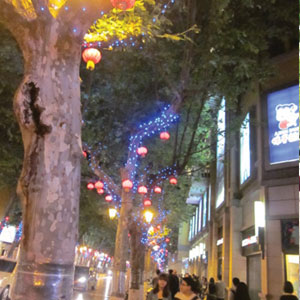
Pretty lamps light up the sidewalks in a high-end shopping district in Kunming.
My last stop, Kunming, the capital of Yunnan, has a downtown commercial district to rival any other mid-level Chinese city but also sports a joie de vivre and charm that is rare in the fast-paced cities of accelerated economic growth. Nestled in southwestern Yunnan, Kunming exudes an old-worldly charm in its tree-lined boulevards, wide lakes, serene Buddhist temples, and expat-friendly coffee shops strewn around those boulevards.
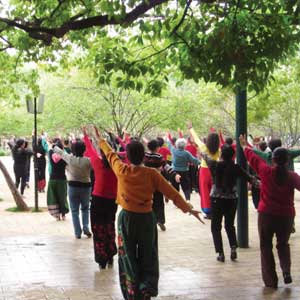
Dancing to Bollywood tunes by the Green Lake Park in Kunming.
One morning, while strolling at the serene Cuihu Lake, I chance upon several dozen young to middleaged women and a sprinkling of men dancing to a remix version of “Mere Naseeb Mein.” They are led by a young Chinese man—perhaps the instructor—in Bollywood-infused gentle hip thrusts and arm movements. Zumba in Southern China to the beats of Bollywood music, I make a note. Young and old alike saunter through the tree-lined sidewalks on the tiny islands on the lake. Teahouses and gift shops line the periphery of the lake. And oh, the tea. Pu-erh tea, white tea, green tea, and black are tastefully displayed in tea boutiques. Dried rose petals, lemon slices, and other aromatic additions to tea are casually heaped up in piles at another store. Pu-erh tea cakes are stacked up milehigh. Even the most agnostic of tea drinkers would be remiss not to try Kunming tea offerings. Buy a bag full and you get front-row tickets to a tea ceremony.
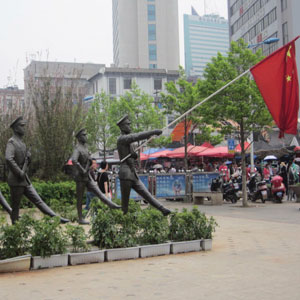
A war memorial in Kunming.
The Seagull Hotel, where we stayed for four nights, is a stone’s throw away from the Cuihu Park and lake area, one of the nicest public areas I came across during my travels. On the sidewalk abutting the lake, one finds several young singers busking for spare change, singing American pop tunes and rock songs. They attract a few onlookers. You could’ve transplanted the buskers to a subway station in NYC and they would’ve fit right in.
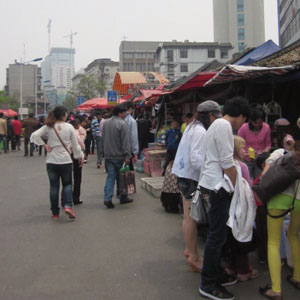
The Yunnan Province is home to more than 20 ethnic minorities in China. Walking around Kunming, one is bound to run into Dai women in their colorful skirts and headgear. Yunnan cuisine is a reflection of its mixed cultural heritage. The flavors draw from other Southeast Asian cuisines and as a result are a delightful blend of sweet, sour, and spicy.
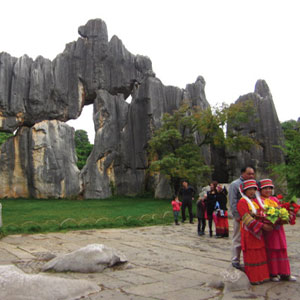
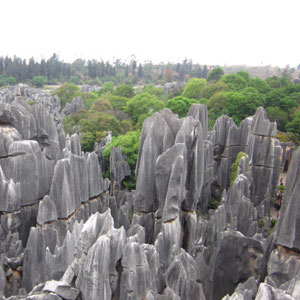
Tourists pose for pictures in traditional garbs at the Stone Forest site near Shilin in Yunnan province.
A couple of hours’ drive south of Kunming takes you to the Stone Forests, now a UNESCO world heritage site. Clusters of tall limestone rock formations stand as somber sentinels guarding the mountains far beyond. A short film presentation is broadcast on the giant television screen at the entrance to the park. The park is spectacularly clean and the grounds well-maintained. While crowded, there are ample opportunities to get lost amidst the formations. Folktales from the Yi people’s mythology add to the Stone Forest mystique. One such tale was woven around a smooth outcropping of rock that I happened to rub. My Chinese colleagues burst into peals of laughter. What? What should I have done? Not rubbed it? Run away from it? Did I just disgrace a local deity? Will I be born as a sewer rodent in my next birth? Apparently, my cultural indiscretions weren’t heinous, just silly.
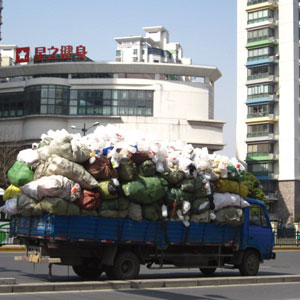
A dump truck in a big city.
An adventure-seeking or business traveler may not run into the gritty China. Unlike cities in India, one doesn’t find slums and shantytowns abutting walled compounds. I didn’t. On the fast train from Shanghai to Nanjing, I caught fleeting images of gritty neighborhoods, and run-down homes by the train tracks. But, the images were not enduring. The first-time traveler is so caught up by the razzle-dazzle of speeding trains, gleaming highways, and tall buildings that she shuts out the imagery more familiar in her homeland.
When I travel, I indulge in what can be called innocuous eavesdropping or benevolent overhearing. What are folks at train stations talking about? What are they laughing at? I could do none of that in China because I didn’t speak the language. So, I couldn’t quite eavesdrop on conversations over tea or at the bus station or at the checkout line at Wal-Mart. But, I would hazard a guess that nobody would be talking politics. Nobody does in China. What happens in Beijing stays in Beijing. “Chinese government rich, Chinese people poor” is what my colleague Shelley tells me when I ask her about the glitzy but inactive government health centers. David, a colleague from Beijing who is a medical doctor, tells me that young, urban Chinese are timid when it comes to speaking their minds. They are happy with their iPhones and fancy cars. Nobody cares really, he says. Why is that, I ask him? Because they have all that they need today. But such complacency can’t be any good for us, he tells me. In hopes to continue this conversation, I ask him for his Facebook ID after I shared mine. David’s eyes widen and he asks, “You can post with your real name on Facebook?” Sure, I tell him, why shouldn’t I be able to? “No, we can’t do that here,” he tells me. Facebook is blocked in China. If you do get on Facebook, you have to use aliases. I think about the story I read on the New York Times about a Mumbai taxi driver who pays to use the internet on his phone. I need to stay in touch with friends on Facebook, he tells the reporter. The bumbling democracy that is India affords an opportunity for self-expression to a taxi driver in India that is denied by the Chinese state to a doctor like David.
My most enduring memory of China will be of snake oil lotions. Snake oil packaged as perfume, moisturizer, and generic unguent. That’s right, a three-star hotel in central Shanghai tried to sell me snake oil! I had finally come face to face with the proverbial snake oil salesman. I didn’t buy any this time around, but perhaps on my next trip, the charms of the Chinese snake oil salesman will convince me to buy some.
Girija Sankar works in International Development for an Atlanta-based NGO. Her writings have also appeared in Eclectica, India Currents, JMWW, Alimentum, Youngzine, and Muse India.
Enjoyed reading Khabar magazine? Subscribe to Khabar and get a full digital copy of this Indian-American community magazine.
blog comments powered by Disqus












